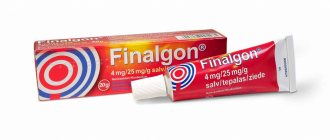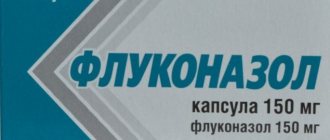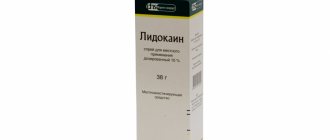The action of nootropic drugs is aimed at improving cognitive abilities and brain functioning in general. Cereton belongs to this group of drugs. The drug provides metabolic protection and promotes the release of choline. This allows you to improve concentration, memory, and improve learning abilities. Against the background of the drug’s action, restoration processes are launched during the development of various pathologies.
pharmachologic effect
Nootropic. The active substance ensures the supply of choline to brain cells. The active ingredient is protected from enzymatic destruction. Choline is actively used in the process of synthesizing phosphatidylcholine and acetylcholine , normalizing the functioning of affected receptors, increasing the membrane elasticity of neuronal cells, and improving synaptic neuronal transmission.
With sufficient supply of choline to the brain, cerebral blood supply is enhanced, the reticular formation is activated, and cellular metabolism is stimulated. After a course of treatment, regression of severe neurological symptoms is recorded, blood circulation in the affected areas of the brain improves, and cognitive indicators improve. The medicine has a positive effect on the bioelectrical activity of the brain of spontaneous origin.
Impact
Cereton, the instructions for use indicate this, has a pronounced cholinomimetic effect. The drug promotes the release of choline in the brain. It is an important nutrient that improves cognitive performance and helps restore brain structures after severe damage.
When taking the drug, blood flow improves and metabolic processes accelerate, which minimizes the risks of developing various pathologies, including those associated with age. Cereton also normalizes brain activity and improves behavioral reactions in the presence of vascular diseases.
Indications for use of Cereton
- senile pseudomelancholia;
- cognitive impairment;
- attention disorder;
- dementia of unknown origin;
- encephalopathy of unspecified origin;
- cerebral infarction ;
- apathy;
- after ONMC ;
- encephalopathy;
- organic mental disorders;
- behavioral disorders of organic origin (with central nervous system dysfunction);
- senile dementia;
- lack of initiative, decreased motivation;
- lack of coordination;
- after intracranial hemorrhages;
- after brain injuries.
Additional indications for the use of Cereton in elderly people:
- psychoorganic syndrome,
- cerebrovascular insufficiency,
- multi-infarct dementia.
When is Cereton prescribed?
Cereton, the instructions for use indicate this, is prescribed for traumatic brain injuries, ischemic and hemorrhagic strokes. The medicine is indicated to relieve acute manifestations. It is also effective during periods of recovery after severe pathological conditions, which are caused by the presence of symptoms indicating damage to the brain stem
Also, cereton, the instructions focus on this, is effective for psycho-organic syndrome. This pathology is accompanied by pronounced symptoms caused by degenerative changes in the brain. The disease can occur at any age, but most often it is provoked by atrophic processes in the brain of older people.
Nootropic medicine is considered effective for the manifestation of cognitive disorders, such as:
- Problems with logical thinking.
- Memory impairment.
- Appearance of confusion.
- Lack of initiative and motivation.
- Loss of concentration.
In old age, the drug is indicated for stabilizing the condition of people with the development of dementia, encephalopathy, and pseudomelancholia.
Side effects
Skin:
- hives;
- rashes.
Digestive tract:
- ulcerative lesions of the stomach;
- constipation;
- gastritis;
- pharyngitis;
- dry mouth mucous membranes.
Nervous system:
- dizziness;
- hyperkinesis;
- convulsive syndrome;
- nervousness;
- anxiety;
- aggression;
- drowsiness;
- migraine;
- ischemic changes in brain tissue.
Rarely, urinary disturbances, diarrhea syndrome , and pain in the injection area are recorded.
Terms of use
Cereton injections are prescribed for acute conditions. In this case, deep intramuscular injection is performed. The solution can also be administered intravenously. Therapeutic dose is 1 ampoule, which corresponds to 1000 mg of the active substance. Duration of use is 10-15 days. Thus, the price of the medicine for one course is quite high.
Cereton tablets are mainly used during the recovery period after traumatic brain injuries and strokes. The duration of treatment with the drug is 6 months. Recommended dose of medication:
- In the morning, 2 capsules, which corresponds to 800 mg.
- During the day, 1 capsule, which corresponds to 400 g of active substance.
For symptoms of dementia and confirmation of circulatory problems in the brain, it is recommended to take 1 capsule three times a day. Treatment lasts 3-6 months.
Instructions for use of Cereton (Method and dosage)
Ampoules are prescribed mainly for acute conditions. The solution is administered intramuscularly or intravenously. Parenteral medication should be administered slowly. Daily dosage – 4 ml (1 ampoule).
The duration of treatment is 10-15 days.
After acute conditions, capsules are prescribed during the recovery period.
Instructions for use of Cereton tablets
2 pieces in the morning, 1 piece in the evening. Duration of therapy is up to 6 months. For cerebrovascular pathology of chronic origin and for dementia , 1 capsule is prescribed three times a day for a course of 3-6 months. The preferred time of administration is after meals.
Release form and composition
Cereton is produced in the form of gelatin capsules and solution for injection. The active substance in the drug is choline alfoscerate. Its content in capsules is 400 mg, in ampoules of 4 ml – 1000 mg.
The capsules are oval in shape and yellowish-brown in color. They are filled with an oily liquid. Auxiliary components used in the manufacture of capsules are glycerol and purified water. The capsule shell is made on the basis of gelatin using other additional components that allow it to be given the desired shape.
Analogues of Cereton
Level 4 ATC code matches:
Delecite
Choline alphoscerate
Cerepro
Gliatilin
Coincidence in pharmacological effects:
- Mexidol
- Actovegin
Structural analogues of Cereton:
- Gliatilin
- Cerepro
Special instructions and reviews
There are no data on interactions with other drugs. There is no effect on psychomotor functions, so there are no restrictions on driving a car or performing any operations requiring precision.
You can find both positive and negative reviews about the drug. Many patients emphasize that after the course of treatment, memory and concentration have significantly improved. Many also note a positive effect associated with slowing the progression of dementia.
All negative reviews, as a rule, contain information that there is no positive result. Negative side reactions of the body are also often observed, due to which it was necessary to abandon the medicine.
Cereton price, where to buy
The cost of Cereton solution is 3 ampoules - about 350 rubles, 5 ampoules - about 550 rubles. The price of Cereton in capsules is about 1000 rubles per pack of 28 pieces. In different regions, the price of Cereton varies depending on the pharmacy chain.
- Online pharmacies in RussiaRussia
- Online pharmacies in KazakhstanKazakhstan
ZdravCity
- Cereton solution for intravenous and intramuscular injection.
250 mg/ml 4 ml 5 pcs. CJSC "Pharm" 573 rub. order - Cereton capsules 400 mg 28 pcs. Artlife LLC Artlife/Sotex
RUB 1,032 order
- Cereton capsules 400 mg 56 pcs. Artlife/Sotex LLC
RUB 1,468 order
- Cereton solution for intravenous and intramuscular injection. 250 mg/ml 4 ml 3 pcs. JSC "Pharm"
RUR 364 order
Pharmacy Dialogue
- Cereton (caps. 400 mg No. 28) Artlife LLC/PharmFirma Sotex CJSC
RUB 1,061 order
- Cereton (caps. 400 mg No. 56) Artlife LLC/PharmFirma Sotex CJSC
RUB 1,569 order
- Cereton (amp. 250 mg/ml 4 ml No. 5) Sotex
RUR 547 order
- Cereton (amp. 250 mg/ml 4 ml No. 3) Sotex
RUR 358 order
- Cereton (caps. 400 mg No. 28) Artlife LLC/PharmFirma Sotex CJSC
RUB 1,068 order
show more
Contraindications and negative reactions of the body
The main contraindications to taking the drug are hypersensitivity to the active ingredient and other components. The medicine is not prescribed before reaching the age of 18 years, as well as during pregnancy and lactation.
Contraindications include the acute stage of hemorrhagic stroke, which, as a rule, develops against the background of high blood pressure.
When taking the drug, allergic reactions may occur: rash and itching on the skin. Other adverse reactions are rare. Nausea is sometimes observed after taking the drug, which is a consequence of the effect of the drug on the peripheral nervous system. When it appears, discontinuation of the drug is not required; it is enough to reduce the dosage.
It is necessary to consult a doctor when the medicine provokes disturbances in the functioning of the central nervous system. For example, during treatment, headaches, sleep problems, and increased excitability occur. It may also be necessary to discontinue the drug if gastritis and peptic ulcers worsen during oral administration, or severe constipation or diarrhea occurs.






